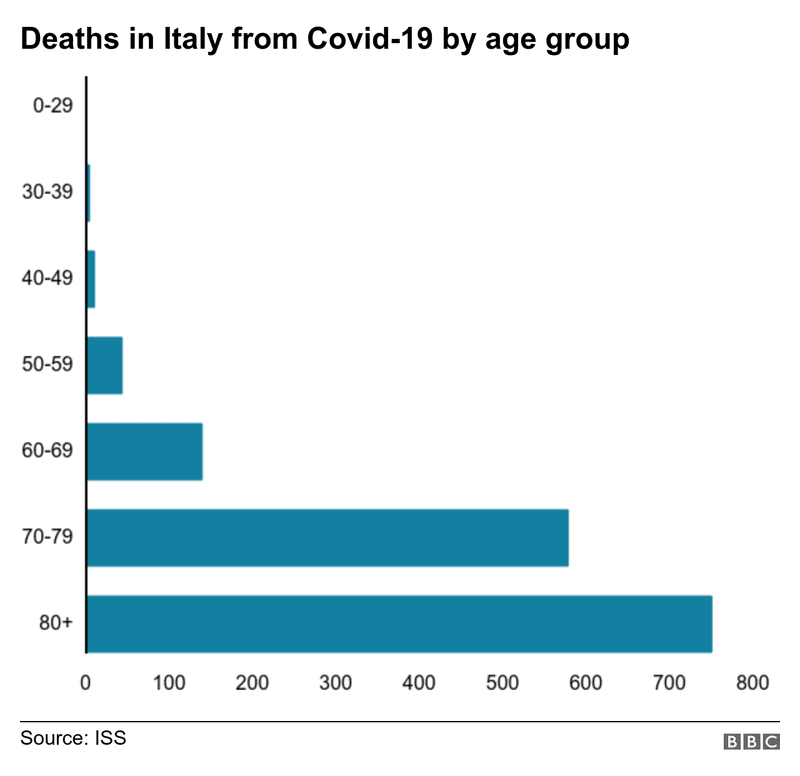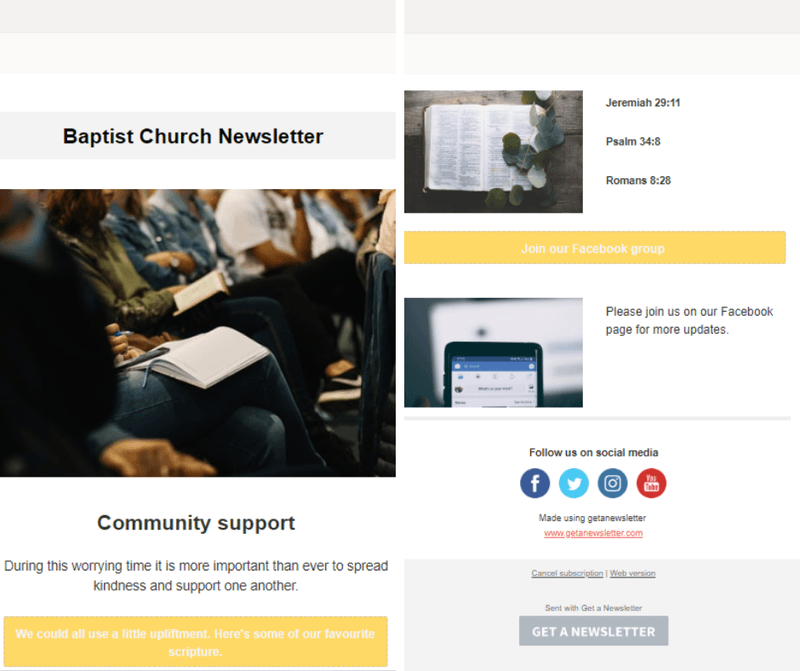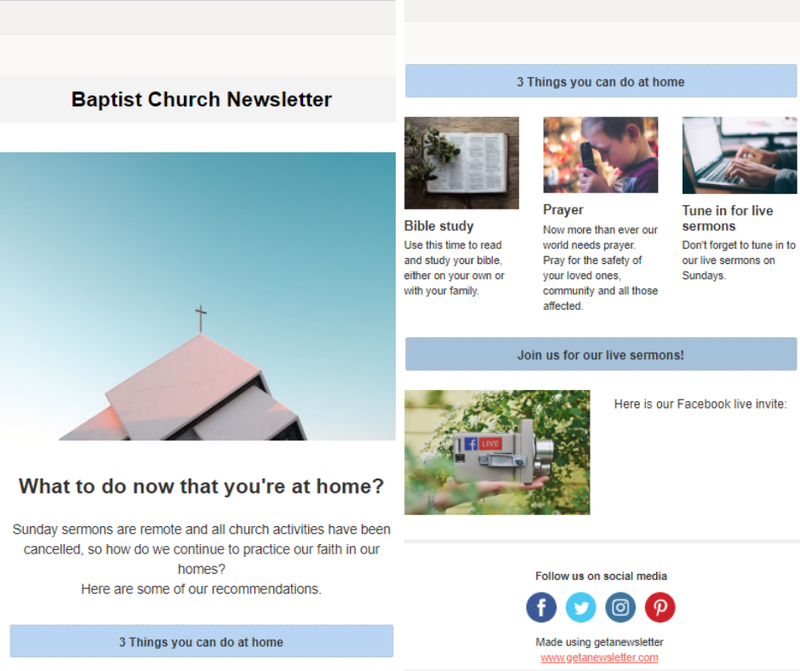When China alerted the World Health Organisation (WHO) to several cases of unknown pneumonia on December 31st in 2019, the virus was unknown and no one had an idea of the impact of it on gatherings of large groups.
At the time, we did not think of how churches can continue serving people during this crisis. As the disease reached more countries, the church community came together and started sharing the best measures to continue serving.
By the 7th of January 2020, officials confirmed that the virus was COVID-19 (Coronavirus) and since then, has claimed the lives of more than 6,600 people worldwide and infected around 172,000 people.
In this post we will show how churches can continue serving during the coronavirus pandemic.
Table of Contents
- Timeline of coronavirus
- Social distancing. What is it?
- Which countries are affected most?
- How to keep serving in times of coronavirus?
- How to make announcements
- How to do church services
- How to do small groups
- How to do pastor’s message
- How to do tithes and offerings
- How to lift people’s spirits
Timeline of the Coronavirus Pandemic
- 17 November 2019 – a 55 year old man is infected with disease in Hubei province in China according to a local newspaper, the South Morning China Post. This is believed to be the first infection of coronavirus.
- 31 December 2019 – China reports several cases of unusual pneumonia in the port city of Wuhan, Hubei province.
- 7 January 2020 – the new virus is confirmed as COVID-19, part of the coronavirus family which includes SARS and the common cold.
- 11 January 2020 – China reports its first death from the coronavirus, a 61 year old man.
- 20 January 2020 – China reported more than 200 cases, including cases in Beijing, Shanghai and Shenzhen.

From 23 January, the Chinese government started to quarantine the most heavily affected cities, starting with Wuhan. This meant that people had to stay in doors, stop working and required a special permit to be allowed outside their homes. Only grocery shops and pharmacies stayed open.
By the 17th of March, the European Commission planned to close the borders for all non-essential travel throughout Europe’s Schengen free-travel zone after the disease spread through Europe, with Italy as the worst affected nation outside China.

What is social distancing?
Social distancing is deliberately increasing the physical space between yourself and others to avoid spreading disease. This means avoiding crowded spaces and gatherings of large groups of people.

For the church, this has been a real dilemma because it has affected how they can serve people and practice their faith. Because the coronavirus is very contagious and spreads fast, churches have had to change the way they do all their activities, including Sunday mass, worship services, prayer meetings and small group gatherings.
The church community has very quickly come up with creative ways to continue serving and it has honestly been a huge worldwide effort of sharing information and resources. In this way, the church community has truly shown kindness, the willingness to help each other and remain positive in this time of crisis and panic.
Because of the rapid infection rate of the disease, the WHO has strongly recommended social distancing and at least 14 days of self-quarantine for those who have traveled to countries with high infection rates. This means that large groups of people should not congregate, especially in confined and enclosed spaces.
Which countries are most affected?
At the time of writing, 162 countries are affected. The seven countries with the highest number of confirmed cases are:
- China – 80, 881
- Italy – 27,980
- Iran – 16,169
- Spain – 11,279
- South Korea – 8,320
- Germany – 7,974
These countries have gone into lockdown which means that all non-essential travel has been banned and social distancing heavily enforced. Businesses had to close down and schools and churches are suspended until further notice. People have been asked to stay in their homes. As a result, church services across the world has been cancelled to avoid spreading the disease and as a precautionary measure.
The Pope announced that the Holy Week celebrations are cancelled at the Vatican in Rome until the 12 April and until then, they will live-stream their services.
The annual pilgrimage to Mecca, the holy city of people practicing the Islamic faith is supposed to take place between 28 July and 2 August. Because of many international air travel bans, people are having to cancel their travel plans and reschedule them for next year.
With Easter, Ramadan, Passover and other holy days coming up in the next few months, COVID-19 will have a significant impact on the worldwide religious calendar for 2020.
Churches and coronavirus – How to serve in times of coronavirus?
Because of social distancing, churches and many other organisations are advised to cancel all in-person meetings until further notice.
Below, we break down church activities and show you different measures you can take to keep serving.
How to make church announcements during the coronavirus crisis
Here are some phrases/words you can use to explain the measures you will be taking. Communicate these announcements via email, text, social media or the church website.
- Dear [church name members], we are postponing all events until further notice. Join our online community this week, more details on our website and social pages.
- In light of the coronavirus outbreak, we are reshuffling and rescheduling all planned events for the next two weeks, including Sunday service. Please stay safe and healthy during this time.
- [Church name] family, during the public health precautions we will be transitioning to online services indefinitely until the safety measures are lifted. We will post updates on our social media channels as soon as they become available.
- We are cancelling all in-person events and gatherings until further notice. In the meantime, we urge the church community to remain calm and practice safe hygiene measures. The church office can be reached via email [insert email address here] for queries and questions.
How to do church services during coronavirus pandemic
- Go live – use the live streaming feature on social media sites like Facebook, YouTube and Instagram. Share the link on church social pages and the church website and get the congregation to tune in!
- Pre-record – record sermons in the church auditorium (you can do this during the week). Edit the video and post it online for viewing during normal service times.
- Devices – keep it simple, use a smartphone or tablet connected to the internet on a tripod for live streaming. If you have a professional camera and tripod, you can use this for pre-recorded services.
- Software – There are plenty of free software like OBS Studio that you can use to help with live streaming and editing. Check out this video for more information.
- Licenses – if you’re using live streaming or pre-recording, read up on the necessary copyright licenses you need for worship music. There are different licenses and regulations per country.
How to do small groups/prayer meetings during the coronavirus
- Online voice calls – use apps like Facebook, Whatsapp or Facetime where you can add small groups of people to the voice call.
- Video calling – if everyone in the group has a stable internet connection, jump on a video call. Use apps and software like Zoom, Jitsi Meet, Skype, Whatsapp video calls, Facetime or Facebook messenger video call.
- Facebook groups – create closed groups on Facebook and invite members. Make a short video of the pastor or small group leader addressing everyone, share a scripture or discuss the topic and ask people to comment or share their own experiences.
- Group chat – use apps like Whatsapp or Facebook messenger and create group chat that people can access from their mobile phones.
How to do the pastor’s message during coronavirus crisis
- Social media – the pastor can do a live video on social media, addressing the coronavirus and sharing short scriptures to encourage members or explaining the way forward.
- Pre-record – shoot a short video and post it to the church’s social pages, send it out via email to members in the church or through instant messaging apps and post it on the church website.
- Email newsletter – create an email newsletter with the latest updates of the church, links to the social channels and website where members can find more information on service times and special measures taken.
How to do tithes and offerings during coronavirus
- Bank transfer – members can do an electronic bank transfer into the church’s bank account. Make the details available on the church website.
- Mail – members can send a cheque in the mail to the church administration offices.
- Text to give – members send a text to a dedicated mobile number, they receive a link where they can register their banking details and link it to the church mobile number. After their bank card has been registered, they text the amount they want to give.
- Apps – use an online app like Tithely where members can donate directly to the church.
How to boost spirits during coronavirus
If people are practising social distancing during the coronavirus, they might have feelings of isolation and loneliness, like reported in China after the quarantine period started. This is common in cases of limited social contact or the disruption of people’s normal routine and activities, like church services for example.

So the church community should be aware of this and make an effort to stay in touch with members so that they don’t feel alone or panicked. This is one of the most important ways of serving during this time, just checking on everyone’s well-being. For elderly church members, social contact is especially important.
Here are some ways you can reach out without breaking the social distancing rule during the coronavirus crisis:
- Emergency chat line – create an emergency chat line where members can send messages if they need help with anything or if they are concerned about their health. This is important for people that live alone.
- Phone calls – make regular phone calls to the elderly or sick and ask them about their day, how they are coping and if they need anything.
- Video calls – check in via video call in cases where people have reported illness. They might think they are fine but you will be able to assess the situation much better if you’ve seen them over video call.
- Prayer requests – ask members to send their prayer requests and have a designated team of people who are responding to these from the safety of their homes.
- Scripture – send daily motivational scriptures via text, email, social media or the church website.
- Playlist – create a worship playlist on the church YouTube channel and share the link with members via email, social channels or text.
- Supplies – find out which members need help with supplies, stores are sold out of essentials like toilet paper and hand sanitizer and this can create panic. The church might be able to organise an emergency grocery delivery service to those in need.
- Care package – make care packages of tissues, sanitizer, chocolate, coffee, sweets and vitamin c boosters and get them delivered to members.
- Keep everyone updated – let people know what’s happening to church services and gatherings as information becomes available.
- Keep calm – send regular messages of encouragement and remind members to stay safe, healthy and to remain calm.
While we are still in the midst of a crisis, we continue to pray for guidance and protection. More than anything, the church community has shown its resilience and ability to adapt in times of crisis.
Email newsletter templates for churches
We created a few examples of templates for churches to use to announce the changing schedules and cancelled events.
Example 1

Example 2

Example 3

Leave a Reply